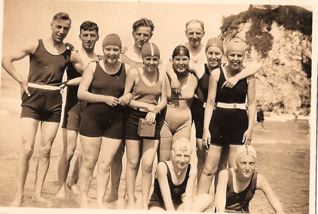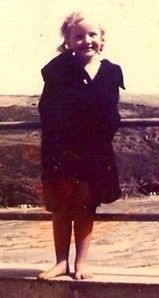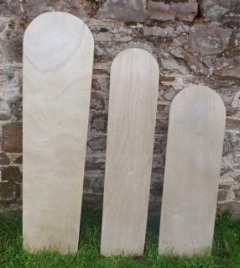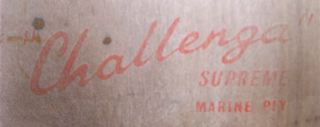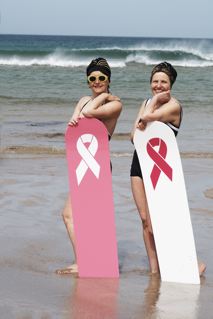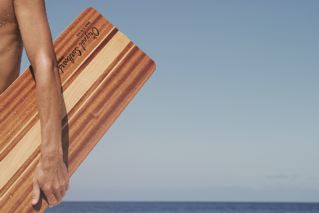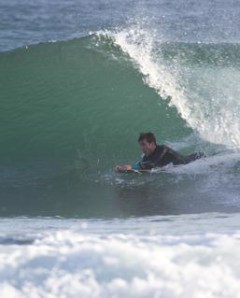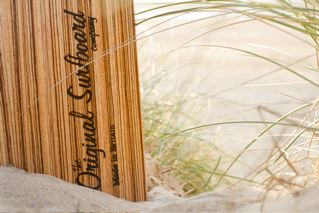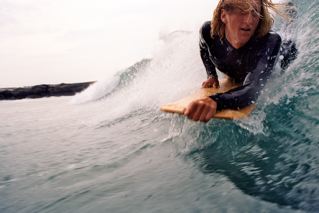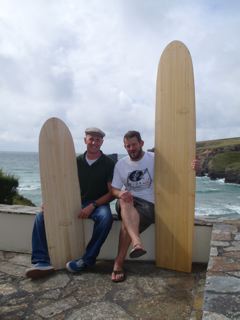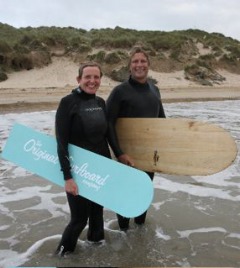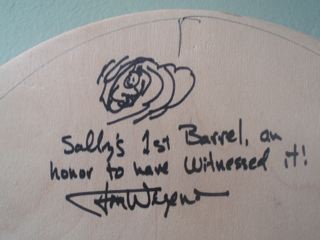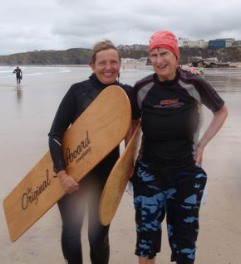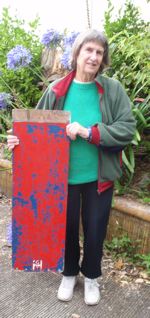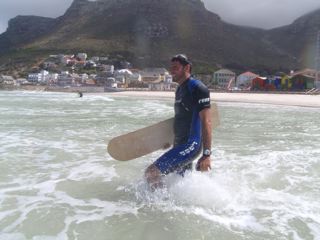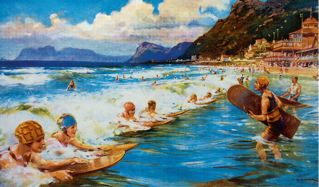Capturing the grace and style of traditional English ply surfboards
| A Paipo Interview
with Sally Parkin November 20, 2011 - Devon, England E-mail questions by Bob Green |
| Sally has ridden
ply boards from a young age and her boards were known
as surfboards. In March 2008, she established The Original Surfboard
Company, which hints at the traditional nature of these boards as well
as reflecting her view that the stand up surfboard industry has usurped
the term 'surfboard.' From a modest start, her boards are now sold
around the world. Their versatility allows people of all ages to surf
in a wide variety of conditions. Sally remains stoked to ride and sell
her boards.
|
4. Were they called
bellyboards back then?We never used to call our boards “bellyboards” - we called them surfboards. I still prefer to avoid using the word bellyboard - it reminds me of belly flops and beer bellies. I only became aware of the bellyboard term in recent years when I got to know people who worked in the surf industry. When the stand up surfboards arrived in North Cornwall in the mid- to late-1960s most people called them Malibu boards while the boards we used were still called surfboards [see Note 1]. It seems to me that the stand up surfers and surf companies began to introduce the term bodyboarding and bellyboarding to differentiate their way of wave riding and to make it more exclusive. |
The Art of Surf Riding, by Ronald Funnell 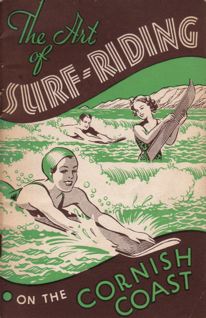 Figure courtesy of Sally Parkin. |
1939
Holiday Haunts guide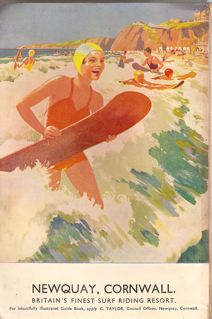 |
A
practical guide to surfing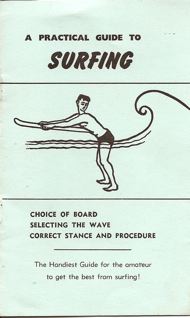 |
Shortly
after setting up The Original Surfboard Company I was amazed
when a well known surfing journalist told me that I couldn't call my
boards “surfboards”. I later discovered that in the 1930s when the
railway companies and the Newquay Publicity Committee first started to
promote Newquay as “Britain’s Finest surf riding resort” they were
referring to these thin wooden boards. It was the Original British Surf
sport. I had no idea at the time that it would be a controversial term
to use. The more research I do the more keen I am to preserve and
revive this original surf riding term. Now when people say these boards
are not surfboards I can wave my 1960s little blue “Practical guide to
Surfing” to prove that “bellyboarding” was originally called Surfing. Figures courtesy of Sally Parkin. |
5. Was this primarily a summer activity when you were young? Yes. We didn’t have wetsuits when we were children and we went in the sea from the May half term through to September. I was lucky enough to be in a house right by the beach for the entire school summer holidays. My sister and I went into the sea every day whatever the weather - we didn’t have wetsuits but we stayed in for hours. The wettest days were often the most fun as there would be hardly anyone in and often the waves were usually better when it was raining. .6. What do you know about the hiring of boards at your local beach? A number of the old Newquay guides advertise the fact that surf-boards were available to hire at all the main beaches.They often included the beach name on the board. |
| 7. What prompted you to start the Original Surfboard Company? | |
In the summer of 2007 a few of our old family boards from the 1960s snapped and I didn’t know where to buy new ones. A friend arrived with a new bright pink painted board which had a “ made by Charles Pearce & Sons” sticker on it. I called and found out that Dick Pearce, then in his late seventies, was still making these boards as he had done for the last forty five years in the Old Tannery in South Molton, North Devon. I went to visit him and bought five boards. It was like stepping back in time - his office had a ribbon typewriter and traditional paper filing systems - not a computer in sight. I was enthralled. |
Dick
Pearcein his office,
2009. Five decades of board building. (12/04/1929 - 10/07/2010)  Photo © John Isaac. |
Sally (right) with friend Sara with |
Over the
next few months I began to think more about the boards and in
particular the pink painted board. My sister had died of breast cancer
in 2004 and for me pink had a strong link with breast cancer ribbons. I
went to the World Bellyboard Championships the same year and saw a
display of boards with amazing hand painted graphics and artwork which
inspired me to think of the boards not just as surfboards but as signs
and works of art too. I approached Cancer Research about the idea of
producing a board with a pink ribbon and asked Dick Pearce if I could
buy blank boards and six months later I launched The Original Surfboard
Company website with eight designs that included two breast cancer
ribbon boards. It felt incredibly special to launch the first breast
cancer boards in memory of my sister. Photo courtesy of Sally Parkin. |
8.
I’ve read about three models – Heritage ply boards,
the High Performance boards and the Supersize boards. How do these
boards differ in design, construction and dimensions?
Apart from the supersize boards - the boards are all the classic British shape - four foot high and one foot wide with a gentle nose rocker. We also make some slightly shorter length boards for children although some adults choose to use these boards. The classic ply boards are all 9mm thick but with the higher grade boards we are able to make thinner five ply boards. These are significantly lighter (as much as 500g!) and more flexible than the classic birch ply boards. I think they are more like the original boards from the 1930s and 1950s, which were very light and thin. During the summer of 2010, I spent a lot of time testing boards with different woods and different thicknesses along with other surfers - Jack Johns took one of the first racing stripe boards into the 2010 World Bellyboard Champs and won the competition with it. He had never ridden a wooden bodyboard before. Last Easter, he and Sam Boex took two of the boards off the reef at Porthleven. It was very exciting to see them being used at such a high level. |
|||||||
9. What difference in
performance do you notice with the
thinner, lighter more flexible boards?
I love the fact that with the thinner boards you feel even more in the wave - the wood grains are also stunning - especially the zebrano veneer. They work best in clean breaking waves - some male riders have said they prefer the all gaboon wood seven ply board as the five ply boards can feel a little too flexi out the back in heavier wave conditions. I have really valued getting feedback from very talented wave riders. |
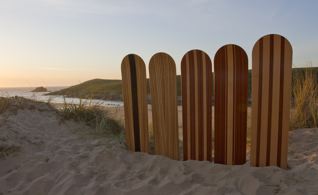 British bellyboards. Photo © John Isaac. |
10.
What’s the construction process and who makes the
boards?
The classic ply boards are made in the same way as Charles Pearce & Sons made them for almost 50 years - cut from manufactured sheets of 9mm marine or birch plywood then steam bent in a press to create the distinctive British nose rocker. The high performance boards are hand crafted by a boat builder using a laminating process with individual sheets of higher grade hardwoods. This means that you can set the exact height of the nose rocker and it will stay set in the same shape - whereas the curve on the steam bent boards will flatten over time as the veneers are weakened during the steaming process. These high performance boards are significantly lighter and have more flex than the birch ply boards. All our boards are made in Britain but we keep the exact location and makers names a secret. |
| 11. Who buys the boards - locals, elsewhere in the UK, or further afield? | |
When I first started the business I sold mainly to friends and family and people who saw the boards being used in Devon and Cornwall. Now I sell more boards to people who live further away although the UK-based customers are often buying them to use in Cornwall, Devon or Wales. I am also shipping an increasing number overseas. Within Europe we’ve had orders from the Channel Islands, the Republic of Ireland, Denmark, France, Spain Portugal, Germany, Sweden and the Netherlands, and beyond Europe, from South Africa, Australia, New Zealand, and just a few days ago we had our first order from Japan. |
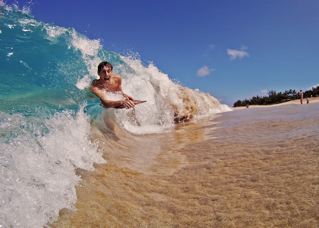 Jack Johns in Hawaii. Photo courtesy of Jack Johns. |
| 12. The average age of the surfers at the bellyboard championships appears much older than you’d see at a standard surfing contest. Is there much interest from younger people in the wooden bellyboards? | |
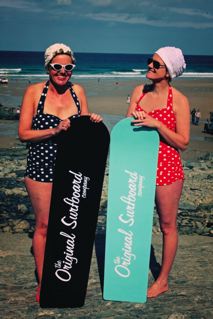 Sally with Margie Wegener at the WBBC 2009. Photo courtesy of Sally Parkin. |
In the early years most
contestants were over
60, but in recent years the under-18 category has grown significantly
and more talented young surfers are competing in the event. A few years
ago most young people would have thought that wooden bodyboards were
strictly for grandparents. For stand up surfers there has also been the
issue of bodyboarding not being surfing. |
| On an international level Tom Wegener has been at the forefront of inspiring surfers to think differently about catching waves lying down on thin wooden boards and James Parry, Jack Johns, Sam Boex, and other talented Newquay-based surfers have been helping to change the perceptions about the original British wood bodyboards. I think one of the most special things about this type of wave riding is that you can do it at almost any age. I was recently on a beach with 84-year-old Dot Long, star of The Life of Ply film, which is on our website. She was giving some 4-year-olds a surf riding lesson and as she said, “There aren’t many sports you can start at 4 and still being doing when you are 84.” | |
13. What criteria are used to judge a winning ride at the bellyboard championships? You’d have to ask the judges! There are lots of different prizes and categories but the spirit of the competition is about the camaraderie and fun of this type of wave riding.14. What type of wave do your bellyboards go best in? One of the great advantages of these boards is that you can use them on almost any wave. If you get to the beach and it isn’t good enough for a stand up surf then you can still have fun on a wooden bodyboard. You can take them out the back with flippers and use them at an advanced level or you can use them in shallow water in broken waves. They’re also great fun at high tide in shorebreak waves.15. Any new models or design ideas planned? I would love to make different shapes and models but this summer we kept selling out of the high performance boards - so I am concentrating on increasing the production of these before starting to introduce other models.16. What is the attraction of bellyboard riding for you? It is the thrill of feeling part of the wave that I think comes from lying down on such a thin board. It’s such fun and I always feel better afterwards - there is something therapeutic about being in the sea and its also a great form of exercise.17. Any surfs or waves stand out from over the years? The first summer I started my company I had a call from someone called John Isaac. By chance I was at Porthcothan - he and Christiaan Bailey came over the same day and brought some Tom Wegener boards with them. It was the start of a friendship and some very special surfing links, including Tom Wegener and his family. |
||||||||||||||||
| 18. Any other comments? | |
My inspiration for setting up The Original Surfboard Company came from a desire to preserve and revive these wooden boards along the Cornish and Devon coastline. I had no idea then that there would be an international interest in my boards and that they would attract the attention of very talented surfers and be used at such a high level. I have also been touched that they evoke such nostalgic memories for people and enthusiasm from complete novices. I think it’s because surf riding is such a simple pleasure that is accessible to all ages and abilities and it brings people together - both in and out of the sea - as one happy customer once said to me, “Sally it’s far more than just a surfboard.” |
Sally
at work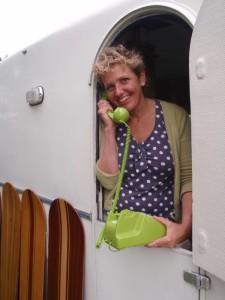 Photo courtesy of Sally Parkin. |
|
Note 1: Extract from a Newquay publicity guide dated 1960 - proof they were still calling this surf-riding and using the term surf-board in 1960, to describe these wooden bodyboards: 1960 Newquay publicity guide extract 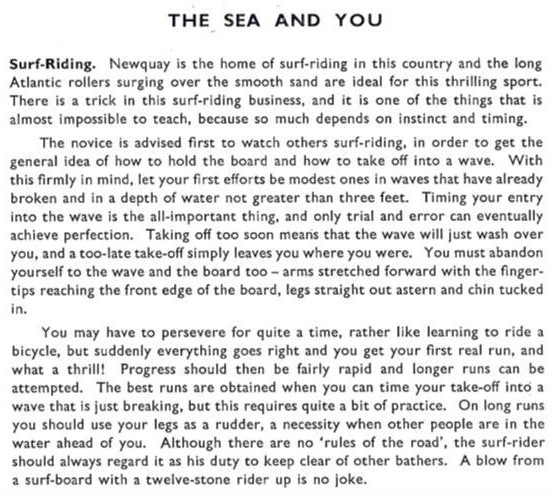 Figure courtesy of Sally Parkin. |
|
Other info: Internet link for The Original Surfboard Company. Feel free to send me suggestions, comments and additional information to: The Paipo Interviews |
